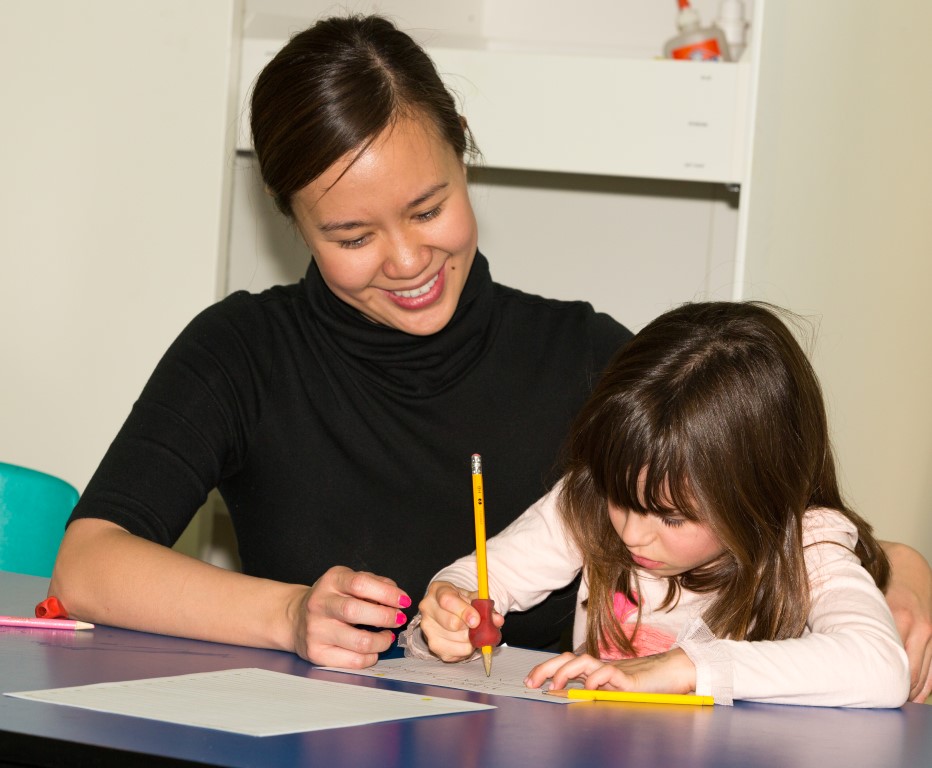occupational therapy
Understanding Interoception-New Insights into Common Childhood Issues
The little known sense, “interoception” might be the reason for common childhood issues with sleeping and potty training.
Interoception is the sense within the human body that enables it to experience, understand and react to the physiological state of itself. It has two main functions: body state and emotional state.
Interoception and Body States
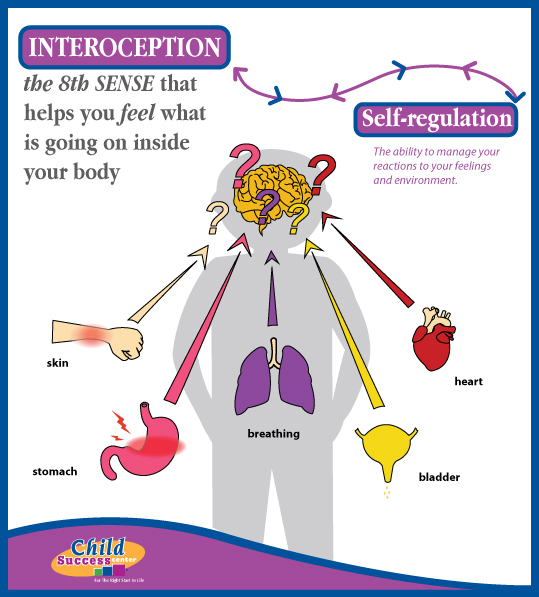 Body states involve the basic functions or physical conditions of the body and interoception allows us to feel and be aware of the inside of our bodies, including organs and skin. It is vital in helping us feel sensations such as pain, tickle, itch, body temperature, hunger, thirst, heart rate, breathing rate, muscle tension, pleasant touch, nausea, headache, sleepiness, and when we need to use the bathroom.
Body states involve the basic functions or physical conditions of the body and interoception allows us to feel and be aware of the inside of our bodies, including organs and skin. It is vital in helping us feel sensations such as pain, tickle, itch, body temperature, hunger, thirst, heart rate, breathing rate, muscle tension, pleasant touch, nausea, headache, sleepiness, and when we need to use the bathroom.
The ultimate goal is for our bodies to reach homeostasis, an internal balance of systems using the least amount of energy. When our internal balance, or homeostasis, is off, our interoceptive system signals our body to take action. For example, if we experience a dry throat and mouth, our interoceptive system, if working properly, will tell our brain that we are thirsty and we need to get a drink of water, which results in decreased discomfort and reduced dry throat and mouth. However, if our interoceptive system is not working properly, signals can be misinterpreted by our bodies, resulting in what presents as an “outburst,” “tantrum,” or “shutdown”, agreeably inappropriate reactions to thirst.
Likewise, if our interoceptive system sends a signal indicating a full bladder and the message is not processed correctly, the appropriate response of heading to a bathroom might not occur. A chronic inability to react appropriately to a given signal can lead to emotional distress and compensatory behavior such as moodiness, nervousness or distraction.
Interoception and Emotional States
Emotional states involve our moods and the emotional conditions of our bodies. The interoceptive system helps us to regulate our emotions, identify our emotions, and determine how we view other’s emotions. It helps us identify anger, embarrassment, happiness, anxiety, excitement, sadness, and fear. For example, a fast heartbeat, tingly stomach, and shaking muscles could mean you are anxious, while slow/rhythmic breathing and loose muscles could mean you are relaxed.
Our ability to self-regulate is closely tied to our interoceptive system. If our interoceptive system is working properly, we are aware of our internal signals (thirst, hunger, full bladder, heart rate, etc.) and able to guide our reaction to those signals. A person with poor emotional awareness could have an interoceptive system that is working inefficiently and therefore not providing clear body signals. Without clear body signals, they may not notice subtle differences in the way each emotion feels and can result in difficulty identifying and controlling those emotions.
Without clear and understood awareness of their internal state, it can be impossible to develop good self-regulation skills, therefore impacting a child’s ability to successfully engage within their social and physical environment. Helping your child begins with learning about treatment options. Occupational therapy, with a focus on sensory processing and with the use of mindfulness activities, can help facilitate interoceptive processing and awareness.
Child Success Center offers many options in the way of treating sensory processing issues and building your child’s interoceptive system. Call today to learn more about our individualized, peer-to-peer and group programs.
Learn more about Child Success Programs that support development of a child’s interoceptive system…
What Your Child May Experience in an Occupational Therapy Session
An occupational therapy session is work for a child’s brain, disguised as play.
A child’s “occupations” include everything he or she does throughout the day – the “jobs of childhood” – the most important jobs being playing, socializing, and learning. The purpose of pediatric occupational therapy is to help a child become comfortable, independent, and proficient in these areas of their lives.
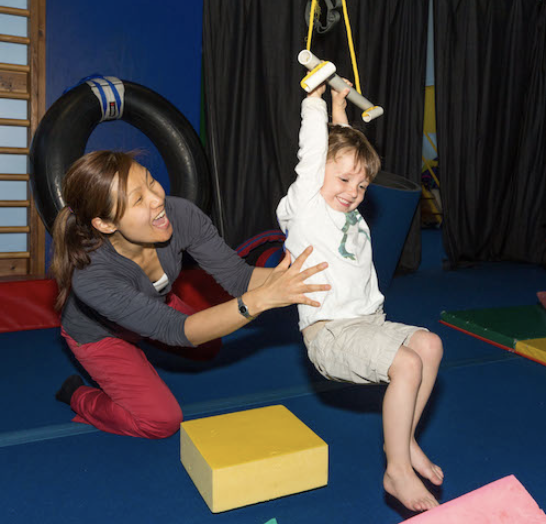 Occupational therapy addresses a variety of areas of deficits including fine motor skills, gross motor skills, social emotional skills and sensory integration. Initial therapy sessions help the therapist to understand the unique wiring of the individual child’s brain and nervous system. The therapist will consult with the child’s parents to ascertain what home and school life are like for the child, and what they have observed in their child’s development. This evaluation and analysis process will continue across subsequent sessions as the child’s nervous system develops.
Occupational therapy addresses a variety of areas of deficits including fine motor skills, gross motor skills, social emotional skills and sensory integration. Initial therapy sessions help the therapist to understand the unique wiring of the individual child’s brain and nervous system. The therapist will consult with the child’s parents to ascertain what home and school life are like for the child, and what they have observed in their child’s development. This evaluation and analysis process will continue across subsequent sessions as the child’s nervous system develops.
Each occupational therapy session is tailored to meet the child’s specific needs, facilitated in a warm and comfortable environment, and created to reflect the child’s interests.
Sensory processing, or organizing, is how a child learns and experiences the world around him. “Just right” sensory experiences during the therapy session will help the child with emotional regulation, self-regulation and social engagement. Intact sensory integration provides the fundamental building blocks for attention, emotional development, motor skills development and higher-level academics and social skills.
An occupational therapy session, utilizing a sensory integration treatment approach, will often target the social-emotional system, employing the Zones of Regulation, Floortime and Social Thinking® (Attributed to Michelle Garcia Winner as creator of the Social Thinking Methodology) programs. Covered would be social skills concepts such as staying with the group, taking turns, collaborative play, and interacting with peers and adults, in order for children to be successful in relationships and group environments.
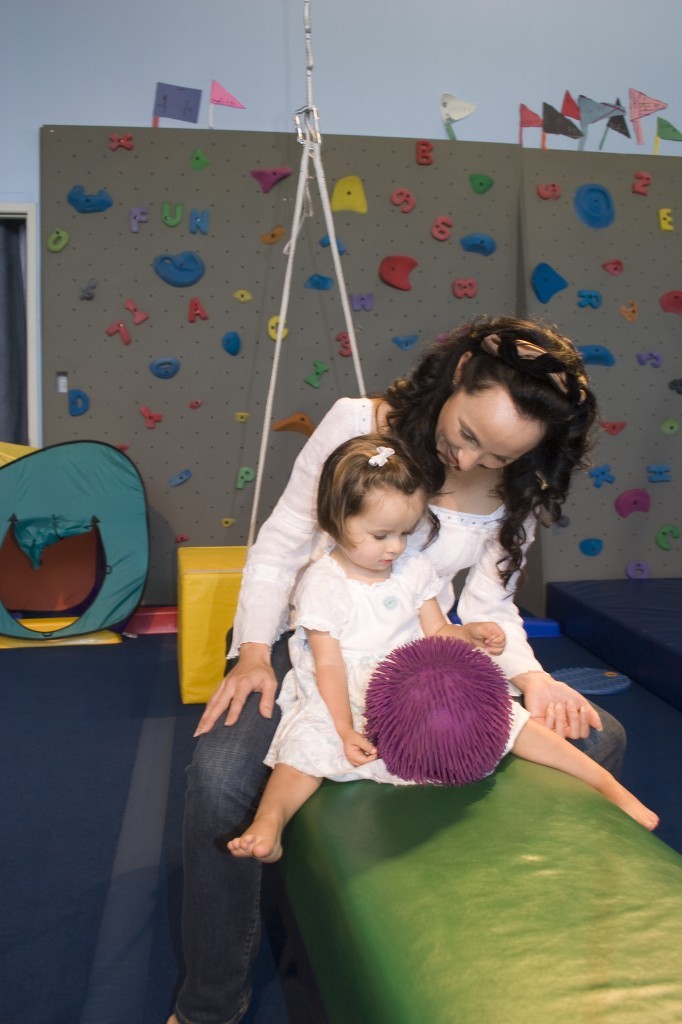 Occupational therapy may work on fine motor skills such as grasp and in-hand manipulation, necessary for drawing, coloring, folding and cutting. Visual motor integration, the ability to use the visual system and the fine or gross motor systems together, and essential to activities such as handwriting, ball play and sports, may be addressed.
Occupational therapy may work on fine motor skills such as grasp and in-hand manipulation, necessary for drawing, coloring, folding and cutting. Visual motor integration, the ability to use the visual system and the fine or gross motor systems together, and essential to activities such as handwriting, ball play and sports, may be addressed.
An OT session might include work on gross motor skills that are involved in playing sports that require bilateral coordination, ball skills, strength, coordination and balance. The therapist will provide easy and creative activities and exercises to help increase upper body and core strength necessary for postural stability, balance, coordination, gross and fine motor control and will often provide a home-based program for follow through.
Often, children who struggle with Sensory Integration and are referred to Occupational Therapy have challenges with Executive Function Skills, necessary for learning and development. In order for a child to plan and organize what they need to do throughout the day, such as getting homework done, they need to be able to focus attention, filter distractions, remember and perform multi-step directions.
Occupational therapy is work for a child’s brain, disguised as play. All children engaged in occupational therapy experience a new level of confidence and self-esteem that comes with learning a new skill or overcoming a challenge. The smile on their face will say it all.
This program, including its teacher or leader, is not affiliated with, nor has it been reviewed, approved, or endorsed by Michelle Garcia Winner and Think Social Publishing, Inc.
Auditory Defensiveness and The Role of an Occupational Therapist
What is Auditory Defensiveness, how are some children affected, and what role does an Occupational Therapist play in treatment?
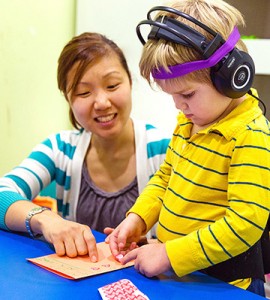
Commonly, when parents and teachers find out that I am a Sensory Integration trained Occupational Therapist, they will ask questions about either sound sensitivity or touch sensitivity. They will tell me about a child who seems unsettled or distressed in loud environments, frequently covers their ears to sounds that other children tolerate, are bothered by noises made by everyday things like vacuum cleaners and hair dryers, or avoids activities that have loud environments such as parties, ballgames, and movies. These children often ask, “Did you hear that? – What’s that noise? – Who’s talking?”, when the parent doesn’t hear anything at all. Parents may also share that their child seems overly sensitive, is anxious in new environments, needs more protection from the world, and exhibits tactile and or movement sensitivity. What these parents are describing is a condition known as “auditory defensiveness”.
When the World Gets Too Loud
Auditory defensiveness is a clinical condition in which a child is highly sensitive to sound. This means that sounds and voices that would not register at all, or would not be perceived as irritating to a typically functioning nervous system, are perceived by the child as too loud, too high pitched, or otherwise difficult to tolerate, and so he must defend himself against them. The child that is moving through their day in a defensive mode can often struggle to stay calm enough to play with friends, learn at school and be part of a family dynamic at home. To survive they may learn to cope by tuning out, hyper-focusing on something else, holding their hands over their ears, attempting to escape the situation in which they find themselves , or by acting out in such a way that the adults are left no choice but to remove them from the situation. Many times the adults around the child will identify a behavior challenge while not always identifying the root. They may struggle to believe that the auditory issue is real for the child, as their nervous system perceives the incoming sound information differently and without struggle. It may be extremely difficult if a sibling close in age is able to process typically, and therefore presents with more flexibility, and overall, an easier child to parent.
A child with auditory sensitivity is alerted to noises that a typically functioning nervous system would recognize as irrelevant and filter out, and may respond to them as if those things were a cause for alarm. As an adult I will equate this to the cocktail party experience. You are often juggling a plate of food, a glass of wine and a conversation with a new person. There is always a lot of back ground noise. For some adults this is not hard work for their ears. For my nervous system, on the other hand, it can be exhausting. I often feel tired from concentrating on the conversation while simultaneously attempting to filter foreground from background sound.
It’s tough to navigate school as well, when your hearing is so sensitive. For the pre-schooler, the classroom often sounds like a cocktail party—lots of children talking at the same time coupled with conflict situations that may include an upset child. For the elementary school aged child the sounds of the bells, children shouting, the echoing noise of the bathrooms or auditorium, the chaos of the playground and the cafeteria, are all experienced as an assault, and will put a child whose hearing is ultra-sensitive on high alert and force him to stay in that mode.
It is very hard to stay calm, regulated and ready to learn, problem solve and share, when your nervous system is in a constant state of alert. For the majority of the school day, children are listening to a teacher’s voice (often a female voice), and for many children the most challenging types of auditory defensiveness is sensitivity to high pitched sound. A high frequency sound dissipates in the air faster than low frequency. Attuning to the teacher’s voice and then holding on to the directions can be difficult, creating additional learning challenges for the child.
A child with auditory defensiveness may also be experiencing other development and/or learning challenges. There are several ways that sensory integration 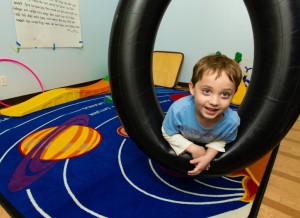 therapy can help a child with auditory defensiveness. An occupational therapist with advanced practice will be able to assess and treat by improving the ability of the inner ear to do the job of filtering and dampening sound. This is done by providing the child with intense movement experiences. Movement affects the workings of the inner ear, which in addition to filtering sound, is responsible for monitoring where we are in space. As one system improves, so does the other. Occupational therapists with additional training can prescribe special filtered music, like the kind used in “The Listening Program”, that trains the ear and brain to be less sensitive to sound. This music can be very helpful to children who have trouble attending in noisy environments.
therapy can help a child with auditory defensiveness. An occupational therapist with advanced practice will be able to assess and treat by improving the ability of the inner ear to do the job of filtering and dampening sound. This is done by providing the child with intense movement experiences. Movement affects the workings of the inner ear, which in addition to filtering sound, is responsible for monitoring where we are in space. As one system improves, so does the other. Occupational therapists with additional training can prescribe special filtered music, like the kind used in “The Listening Program”, that trains the ear and brain to be less sensitive to sound. This music can be very helpful to children who have trouble attending in noisy environments.
Sensory integration therapy works on improving the way that the nervous system function registers, integrates and processes sensory input. An occupational therapist trained in sensory processing employs specific techniques that may include integrating primitive reflex patterns that can often support development.
There are also strategies, that when designed for the individual child and his/her environment, are often referred to as a sensory diet. These strategies may include:
- Modifying the environment (such as in a school) by considering the acoustics in the classroom. Changing seating arrangements may be beneficial and limiting extraneous noise from the hallway by closing the door or windows is also helpful. It may be necessary to cover the loud speaker with material to tone down the volume.
- Having rugs or carpet on the floor will decrease echo and extraneous noises.
- Whenever possible, children should be given advance notice about bells, announcements, fire drills, etc.
- Having the child wear headphones or earmuffs that cover the entire ear to filter out extraneous background noises.
- Playing calming music such as Mozart in the headphones or as background music.
- If concentration is an issue, the child should chew gum, suck on sour candies, and/or eat fruit roll ups, or crunchy snacks.
Generally speaking, a smaller, quieter, more structured classroom is a better fit for a sensory defensive child. I also advise parents not to expect their child to be able to tolerate concerts or to endure long stays at noisy family gatherings until the problem is corrected.
I am often asked if the problem is permanent. Auditory sensitivity may or may not go away, but with appropriate intervention, it should at least, diminish. Sometimes children grow out of their defensiveness and sometimes sensory integration therapy can eradicate it completely. Devising coping strategies, like keeping earplugs and something to chew on in your child’s backpack, helps him feel more in control.
Remember our children need us to play detective. Find out the reason for the behavior. Believe that is it often real for them, even if you don’t feel it, and try to put strategies in place to keep their nervous system calm.
And, as always, you’re not alone. If you have any concerns about your child’s auditory sensitivities, seek out the expertise of a sensory integration trained occupational therapist – they can help make life better for your child and your family.
Frequently Asked Questions about the Role of the Occupational Therapist in Sensory Integration
What is a Sensory Diet?
Sensory Diet – Ways an OT (Occupational Therapist) works with Children and Families to Support Regulation
What really is a sensory diet?
Many occupational therapists use the term, “sensory diet”, when working with children with developmental and/or learning challenges. The term sensory diet was coined by Patricia Wilbarger, M.Ed., FAOTA, OTR in 1984 to indicate the use of a combination of sensory strategies to keep a person at the optimal level of arousal. All human beings unconsciously use sensory diets every day. We exercise, drink coffee, listen to music, retreat to a quiet space when the world gets overwhelming, chew/crunch and eat foods that often make us happy.
Self-regulation is something everyone continually works on, whether we are cognizant of it or not.
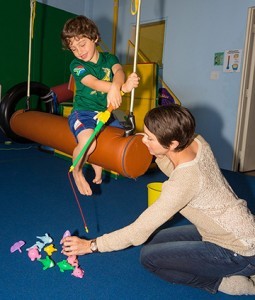
Children who are struggling with self-regulation and utilizing the “just right” behaviors that are expected in different environments do not have the mindfulness, resources or control to seek out the activities that may help them shift from the Red Zone (mad, angry) or the Yellow Zone (silly, out of control, anxious) to the Green Zone (ready to listen and learn). Learn more about the Zones of Regulation.
“Sensory modulation” is a therapeutic term used to describe one’s ability to respond appropriately to sensory input and to stay focused on the activity at hand. It may be used with regard to children and adults who may be under- responsive, sensory seeking and or over responsive. It is never black and white. Working with an occupational therapist will help parents and teachers get a better understanding of the why, what and how of “sensory modulation”. The OT will help parents understand the behaviors of a child, help to identify and remove triggers from their environment and better equip the child’s nervous system to cope with the highly sensory world we live in.
An occupational therapist that has spent time assessing a child’s responses to various sensory information, known as “sensory processing/integration” , will design a sensory diet tailored to that child’s needs. This “diet” will include the tools required, (deep pressure, hugging, taking a break, belly breathing, drinking water, wall pushes) and a schedule outlining when to use them, that will support a child’s overall regulatory state and therefore ability to engage in relationships and his/her environment in a successful way.
Additional Resources for Sensory Processing Disorder and Sensory Integration
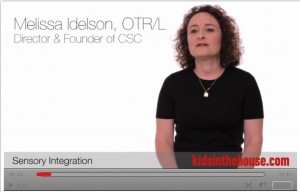 Sensory Processing/Sensory Integration
Sensory Processing/Sensory Integration
What is Sensory Integration – Video
Sensory Processing Disorder Foundation
Handwriting – Dying Art or Important Skill?
Is handwriting a dying art or is it still an important skill to master?
“My child’s handwriting is illegible. Do I need to do anything about this? Why do many children struggle with handwriting legibility? Does my child really need to learn handwriting?”
There has been some discussion recently about the viability and necessity of learning penmanship skills. Yet research shows that writing by hand engages the brain and is a vital component of literacy. Since handwritten testing throughout the school system is unlikely to change any time soon, learning to write quickly and clearly is an important means to an end. With the adoption of the Common Core State Standards, the emphasis and expectations placed on classroom note-taking and expository writing in grades K–5 is greater than ever.
Whether a child prints or uses cursive writing, it must be legible to convey correct test answers, thoughts, instructions, etc. throughout his academic career and life. Therefore “hand writing” is a skill that must be learned and serves many purposes besides legibility.
While we may take the ability to write correctly for granted, many support skills must first be learned requiring the hand, eyes and brain to work in harmony. This becomes more challenging when a child is experiencing a delay in certain areas of development. This in turn can leave a child with feelings of frustration, decreased confidence and success, and often results in avoidance of the very repetition necessary to build skill.
The years between the ages of 3 and 5 are the time your child will build the motor coordination required to develop the dexterity, hand strength and endurance to shift from a fisted grasp to an adult 3 finger, (tri-pod) dynamic grasp that will allow them to control the pencil with ease.
In order to successfully engage in the Kindergarten curriculum, the foundations for a successful pencil grasp and control need to be in place. Core strength for body control to sit up right and arm strength to hold the paper still and stabilize the writing arm need to be well developed before the art of learning handwriting can occur. Their eyes need to work together to hold a focal point and track and be ready to shift gaze across the paper and from the board to the paper and back with ease. The visual memory system needs to be strong to retrieve the images of letters and begin to make sense of what they are seeing by adding meaning through the matching of sounds with each symbol. Reading and handwriting are a partnership – when one grows the other gets supported.
So why do some children struggle with handwriting and how do we help them?
When this very complicated neurological process has a hard time coming together, a child can be left with feelings of frustration and decreased confidence. Fundamental skills are often learned in the form of play for children and not work. They are driven to continue activities by feeling good and having fun. When the activities in the preschool years such as cutting, drawing, beading, climbing and catching a ball are not easy for them they often have the choice to avoid them, thus not engaging in the repetition actually needed to master the skill.
Teachers and parents may not notice that the child is avoiding these types of play especially if the child is exceptionally verbal and engaging. As adults, we need to be aware that children need to have healthy exposure to activities that will develop their nervous systems during the pre-school years in preparation for activities such as handwriting.
How do I know if my child will get past his difficulties?
Development is an individual process as each child has their own unique brain and their own sets of natural gifts and challenges. When engaging in general activities, parents and teachers can help children by:
- Making the child feel emotionally safe and excited to engage in the activities they may want to avoid.
- Grade the activity down to a level the child can easily engage in.
- Keep the activity as child driven as possible.
- If you are struggling to work with your child consult an Occupational Therapist. OT’s are highly trained in assessing the foundational neurological processes that are the base for all play and learning. They are able to let teachers and parents know if the struggle is rooted in lack of exposure, a mild delay that will catch up on its own, or truly an inefficient processing system that needs guidance and the right support to spring board into a positive outcome.
- If in doubt, ask.
Simple things you can do to help your child with his handwriting skills:
- Make sure your child is seated in a chair and at a table that allows for an upright posture with their feet firmly on the floor. Keep the ankles, knees and hips bent at approximately 90 degrees.
- Encourage the non-dominant hand to support the paper.
- Take a small cotton ball and place it under the 4th and 5th digits and secure it into the palm to help build the separation of the 2 sides of the hand to increase pencil grasp.
- Play bouncing, throwing at a target and catching games.
- Draw letters on each other’s back and try to guess the letters.
If left un-monitored, children may begin to:
- Have a negative relationship with learning
- Write a few words instead of the many ideas and thoughts they would like to share
- Have decreased confidence and self-image related to written work.
- Spend valuable brain energy on the handwriting process instead of the thoughts and ideas and learning process
Handwriting should be fun and requires the whole brain and the whole body.
The “Handwriting Club” at Child Success Center is a program customized to meet each child’s needs. Program is designed and run by licensed and highly skilled Occupational Therapists and features multi-sensory strategies, whole brain learning, and the extremely successful Handwriting Without Tears® program.
For more details or to enroll, call Child Success Center at 310/899-9597 or e-mail: enroll@childsuccesscenter.com
Related articles:
Teachers Still See Need for Cursive Writing
New Occupational Therapist Joins Child Success Center Team
The Occupational Therapy Team at Child Success Center is pleased to welcome Gina Yoo as it’s newest member.
Gina Yoo, MS OTR/L, comes to us with 12 years of experience in the field of Pediatric Occupational Therapy. She has worked with individuals ranging from 0-21 years old with a variety of diagnoses, ranging from developmental delay to Autism to Down Syndrome. She is a graduate of Thomas Jefferson University, Philadelphia, Pennsylvania, with a Master of Science in Occupational Therapy. In addition, she is certified in auditory programs such as Therapeutic Listening and Integrative Listening Systems (iLs).
She has also worked with other disciplines throughout her career such as speech and language pathology, physical therapy, developmental optometry and psychology to enhance the therapeutic experience not only for the child but the family as well.
Gina’s main goal is to provide a safe, supportive and therapeutic environment to promote each child’s optimal performance, build self-esteem and teach skills to enhance their quality of life and academic success. In addition, since the family is an integral part of the therapeutic team, Gina feels it is essential to involve them in the process and selection of activities for carry over in the home and community.
We welcome Gina to Child Success Center and look forward to introducing her to our families!
For more information on the Child Success Center’s Occupational Therapy Programs click here.
